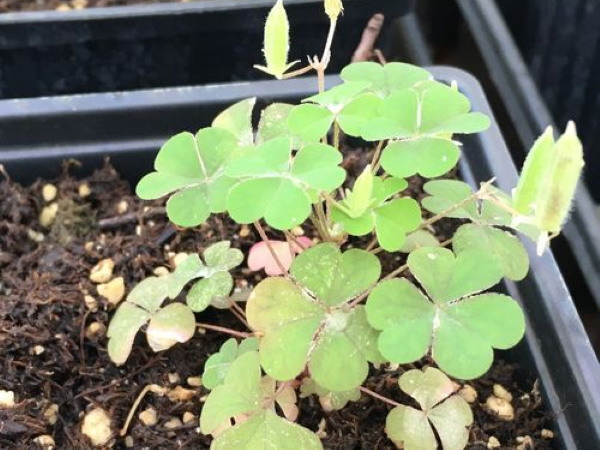Container-grown ornamentals need to be weed-free as weed competition can reduce the overall growth and market value of the ornamentals, and for aesthetics. Oxalis (Oxalis stricta), also known as yellow woodsorrel, is one of the most common broadleaf weed species in container nurseries and greenhouses in Michigan. Oxalis is difficult to control because it can spread by rhizomes, stolons and by seeds, which have no dormancy requirement. It is native to North America and is widely distributed throughout the world. Oxalis grows naturally in woodlands, grasslands, disturbed areas and turf. In nurseries and greenhouses, it can be found growing in the drain holes of containers, container nursery stock or on the surface of container media (see photo) under both full sun and partial sun conditions.

A mature yellow woodsorrel (Oxalis stricta) growing on container media surface inside a greenhouse. Photo by Debalina Saha, MSU Horticulture.
Oxalis is herbaceous and usually grows upright with extensive branching but may also grow flat along the soil surface. The cotyledons of the seedlings have a pinkish tint with alternate trifoliate leaves. The primary root system structure is a tap root, although rhizomes (underground stems) can also form secondary fibrous root structure. The stems are soft, herbaceous and light green. Leaves are alternate, palmately compound, with smooth margins and heart-shaped leaflets. Flowers are small, bright yellow with five petals and blooms from spring through fall, according to Lollar and Marble, 2015. The seedpods (fruit) of oxalis are capsules that resemble the shape of okra pods.
A single oxalis plant can produce up to 5,000 seeds per year and have an almost 100% germination rate immediately after dispersal. Oxalis seeds are photoblastic, meaning they require light for germination, and the optimum temperature requirement for germination ranges from 50 to 84 degrees Fahrenheit.
Best practices for managing yellow woodsorrel in container production require a combination of herbicide applications along with proper cultural and sanitation practices. Several preemergence and postemergence herbicides labeled for use in ornamental production have shown effective control of this weed species. In addition, certain herbicides have even resulted in early postemergence control of oxalis in container production.
A Michigan State University Extension bulletin, “Identifying and Managing Yellow Woodsorrel (Oxalis Stricta L.) in Nurseries and Greenhouses,” has been developed where identification and management strategies of yellow woodsorrel for container production has been discussed. This bulletin can be a useful resource for nursery growers and greenhouse operators to choose the right method for controlling oxalis according to their production system.
Source: Michigan State University (Debalina Saha and Heidi Lindberg)
